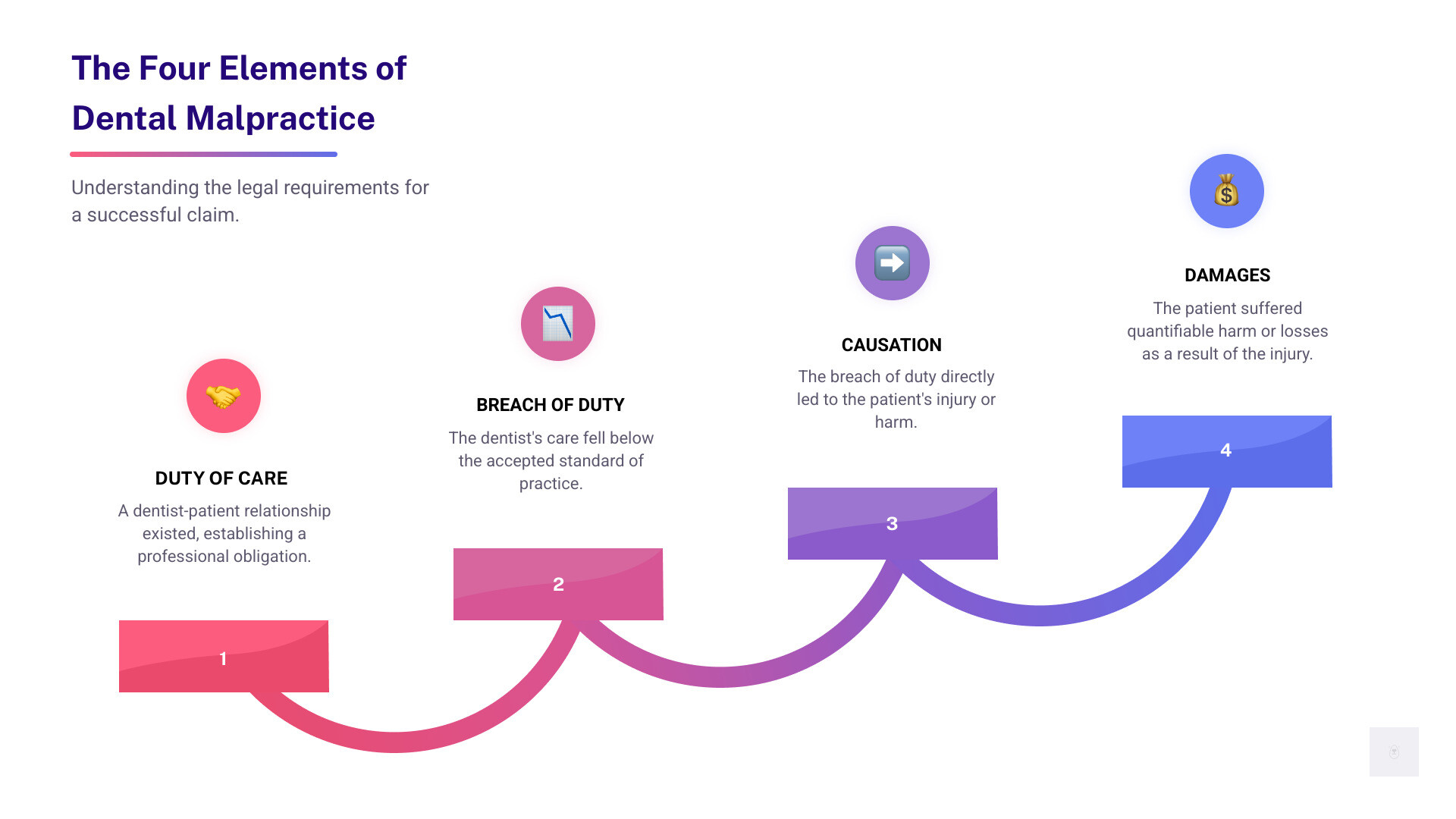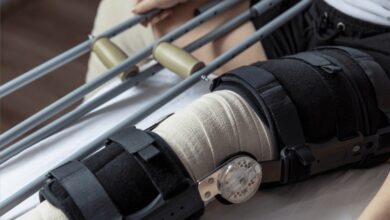When Your Dentist Causes Harm: A Look at Dental Malpractice
Learn what dental malpractice is, common injuries, and your legal rights if a Utah dentist caused harm. Know your options and protect your health.

We all trust our dentists to take care of our oral health. A dental visit should bring relief, not further problems. But sometimes, things go wrong.
When a dental professional’s actions fall below accepted standards and cause harm, it can be a serious issue. This is known as dental malpractice. It is a breach of the trust we place in our healthcare providers.
Understanding what dental malpractice means is crucial. It helps us know our rights when things don’t go as planned.
We will explore what dental malpractice truly is. We will look at common injuries that can occur. We will also guide you through the legal steps involved in such cases. Knowing your options, especially if you have experienced a Utah dentist caused injury, is important. Our goal is to empower you with knowledge and clarity.

Dental malpractice occurs when a dentist, oral surgeon, or other dental professional fails to meet the accepted standard of care, resulting in injury or harm to the patient. This isn’t merely about a procedure not yielding the desired aesthetic outcome; it’s about a deviation from professional standards that causes tangible damage. In the UK, for instance, dentists are held to rigorous professional standards governed by bodies like the General Dental Council (GDC), which ensures a baseline of competence and ethical practice. Similar regulatory bodies exist across different jurisdictions to uphold these standards.
When a dentist’s actions, or inactions, fall below this standard, the resulting harm can be classified as an iatrogenic injury – an injury caused by medical examination or treatment. These can stem from operator error, equipment malfunction, or even a failure to adequately assess a patient’s condition. Understanding this foundational concept is key to recognizing when a “bad outcome” crosses the line into professional negligence.
What is the “Standard of Care” Expected from a Dentist?
The “standard of care” is a cornerstone of dental malpractice law. It refers to the level of competence and treatment that a reasonably skilled and prudent dental professional would provide under similar circumstances. It’s not about perfect outcomes, but about reasonable care. As Mahsa Dabirian, a partner at Bogoroch & Associates LLP, notes, “Dentists have an obligation to provide services that meet the standard of care for all patients, and when they fail to do so malpractice can occur.” This includes everything from the initial diagnosis and treatment planning to the execution of procedures and post-operative care.
For example, a dentist is expected to conduct thorough pre-treatment assessments, clearly explain risks and benefits of proposed treatments, and obtain informed consent from the patient. They must use sterilized equipment, administer treatments safely, and possess the necessary judgment and diligence. The standard of care is often defined by what a community of dentists practicing in the same field would consider reasonable and prudent. When assessing a potential malpractice claim, legal experts and other dental professionals will examine the dentist’s technique, education, judgment, and diligence to determine if they fell short of this accepted benchmark.
Can a Dentist Be Liable for Misdiagnosis?
Absolutely. A dentist can certainly be held liable for misdiagnosis or delayed diagnosis if it leads to patient harm. This falls under the umbrella of dental malpractice, as it represents a failure to meet the standard of care in a critical aspect of patient management. Misdiagnosis can occur in various forms:
- Failure to diagnose a serious condition: This is particularly critical with conditions like oral cancer. Dentists have a duty to check for any growths, lesions, or signs of oral cancer during routine check-ups. A delayed diagnosis can lead to metastatic spread, necessitating extensive surgeries, chemotherapy, and radiation, drastically altering a patient’s life.
- Incorrect diagnosis: A dentist might misinterpret symptoms or X-rays, leading to an incorrect diagnosis that results in unnecessary procedures or the worsening of the actual condition.
- Delayed diagnosis: Even if a correct diagnosis is eventually made, if it was delayed due to negligence, and this delay caused the patient’s condition to worsen or required more invasive treatment, liability can arise.
To prove liability for misdiagnosis, it must be demonstrated that a reasonably competent dentist would have made the correct diagnosis or a more timely diagnosis under the same circumstances, and that this failure directly caused the patient’s injury or worsened their prognosis. This often requires expert testimony to establish what the standard of care dictated in that specific situation. Learn more about how a failure to diagnose can lead to serious legal consequences.
Common Injuries and Identifying Liability
When dental work goes wrong, the consequences can range from minor discomfort to severe, life-altering injuries. These injuries often form the basis of dental malpractice claims, highlighting instances where a dentist’s negligence has caused harm. Common types of injuries include nerve damage, infections, anesthesia errors, wrong-site surgery (such as extracting the wrong tooth), broken teeth, and jaw injuries like TMJ disorders.
What Happens if a Dentist Hits a Nerve?

Hitting a nerve during a dental procedure is a serious concern that can lead to significant and lasting pain or dysfunction. If you feel a sudden, sharp, or shooting pain during a procedure, or experience numbness or tingling in your lips, tongue, or other mouth areas afterward, it could be a sign of nerve irritation or damage.
The most commonly affected nerves in dental procedures are the inferior alveolar nerve and the lingual nerve, both crucial for sensation in the jaw, teeth, and tongue. Damage to these nerves can result in:
- Numbness or paresthesia: A tingling, burning, or “pins and needles” sensation.
- Dysesthesia: An unpleasant, abnormal sensation, which can be painful.
- Loss of taste: If the lingual nerve is affected.
- Difficulty speaking or eating: Due to altered sensation or muscle control.
Causes of nerve damage can include direct trauma from a drill or needle, compression, or chemical irritation. For instance, during root canal treatments, calcium hydroxide can extrude through the apex, causing chemical, mechanical, and/or thermal injuries to the inferior alveolar nerve, potentially leading to neurological disorders.
The healing time for dental nerve damage varies greatly. Some minor irritations might resolve in days or weeks. However, severe cases can take months or even years to heal, and unfortunately, some damage can be permanent, leading to chronic pain or sensory loss. If your dentist caused nerve damage, seek immediate attention and understand your options. For more information on this specific issue, you can consult resources like “My Dentist Caused Nerve Damage, What Can I Do?” on Trustpilot.
Who Can Be Held Liable in a Dental Malpractice Case?
Determining liability in a dental malpractice case can sometimes be complex, as multiple parties might share responsibility. While the treating dentist is often the primary focus, other individuals or entities within the dental practice can also be held accountable. Here’s a breakdown of potentially liable parties:
- The Treating Dentist: This is the most common defendant. The dentist is directly responsible for providing care that meets the standard of care. If their actions (or inactions) fall below this standard and cause injury, they can be held liable.
- The Dental Hygienist or Assistant: If a hygienist performs a procedure outside their scope of practice, or if their negligence (e.g., improper scaling, dropping an instrument, poor sterilization) leads to injury, they can be held liable. Similarly, dental assistants can be liable for errors within their duties.
- The Oral Surgeon or Specialist: If a general dentist refers a patient to a specialist (like an oral surgeon, periodontist, or orthodontist) and that specialist’s negligence causes harm, the specialist is typically the liable party. In some cases, if the general dentist made an improper referral or failed to refer when necessary, they might also share some liability.
- The Dental Clinic or Practice Owner: The clinic itself, or its owner, can be held liable under several doctrines. For instance, under “vicarious liability” or “respondeat superior,” an employer can be held responsible for the negligent acts of their employees (dentists, hygienists, assistants) if those acts occurred within the scope of employment. Additionally, if the clinic has systemic issues like inadequate staffing, faulty equipment, or poor infection control protocols, the practice itself can be directly liable.
- Product Manufacturers: In rare cases, if a patient’s injury is caused by a defective dental product, instrument, or material (e.g., faulty implant, contaminated filling material), the manufacturer of that product could be named in a lawsuit.
Understanding who can be held responsible is crucial for victims seeking justice and compensation. An experienced legal team can help identify all potentially liable parties to ensure a comprehensive claim.
What Are the Consequences of Poor Infection Control?
One of the most critical aspects of dental care is maintaining stringent infection control. Failure to adhere to proper sterilization and hygiene protocols can have devastating consequences for patients, leading to severe infections and, in some cases, life-threatening conditions.
Poor infection control can manifest in various ways:
- Inadequate Sterilization of Instruments: If dental instruments are not properly sterilized between patients, bacteria, viruses, and other pathogens can be transmitted, leading to cross-contamination.
- Unsanitary Environment: A dirty operatory, contaminated surfaces, or improper waste disposal can all contribute to the spread of infection.
- Lack of Personal Protective Equipment (PPE): Failure of dental staff to use gloves, masks, and eye protection can put both patients and staff at risk.
The consequences for patients can be dire, including:
- Localized Infections: Abscesses, cellulitis, or osteomyelitis (bone infection) at the site of dental work.
- Systemic Infections: Infections that spread throughout the body, potentially leading to sepsis, a life-threatening response to infection.
- Specific Conditions: Conditions like Ludwig’s angina, a severe infection of the tissues in the floor of the mouth, which can rapidly obstruct the airway and be fatal if not treated promptly.
- Transmission of Bloodborne Pathogens: In the worst-case scenarios, improper sterilization could lead to the transmission of diseases like Hepatitis B, Hepatitis C, or HIV.
Beyond the immediate harm to patients, dental practices found to have poor infection control face severe legal and professional consequences. These can include investigations by health authorities, fines, practice suspension, license revocation, and significant malpractice lawsuits. Patients who suffer infections due to a dentist’s negligence may be entitled to compensation for medical expenses, pain and suffering, and other damages incurred.
Navigating the Legal Process After a Utah Dentist Caused Injury

When you suspect you’ve been harmed by a dentist’s negligence, the thought of navigating the legal system can be daunting. However, understanding the process is the first step toward seeking justice. Legal requirements for dental malpractice cases are stringent, often requiring meticulous documentation and expert testimony. For individuals in Utah facing such a situation, it’s crucial to understand the state-specific rules and how to effectively prove negligence and document your harm.
What Are the Legal Requirements to Prove Malpractice?
To successfully pursue a dental malpractice claim, four essential elements must be proven. These elements establish that the dentist was negligent and that their negligence directly caused your injury:
- Duty of Care: This is the easiest element to prove. It simply means that a dentist-patient relationship existed. When you seek treatment from a dentist, they automatically owe you a professional duty to provide care that meets accepted standards.
- Breach of Duty (Negligence): This is where you must demonstrate that the dentist failed to meet the established standard of care. Their actions, or inactions, must have fallen below what a reasonably competent and prudent dental professional would have done in similar circumstances. This often requires expert testimony from another dentist who can attest to the breach.
- Causation: You must prove a direct link between the dentist’s breach of duty and your injury. It’s not enough to show that the dentist was negligent; you must show that their negligence specifically caused your harm or worsened your condition. This can be complex, as pre-existing conditions or other factors might be argued as the cause of injury.
- Damages: Finally, you must demonstrate that you suffered actual, quantifiable harm as a result of the injury. This includes economic damages (like medical bills for corrective procedures, lost wages, and future care costs) and non-economic damages (such as pain and suffering, emotional distress, and loss of enjoyment of life).
Without proving all four of these elements, a dental malpractice claim cannot succeed. This is why gathering evidence, consulting experts, and retaining experienced legal counsel are critical steps.
What Are the Steps in Filing a Lawsuit?
Filing a dental malpractice lawsuit is a multi-stage process that requires careful planning and execution. Here’s a general overview of the steps involved:
- Initial Consultation: The first step is to consult with a personal injury lawyer specializing in dental malpractice. During this meeting, you’ll discuss your experience, provide initial documentation, and the attorney will assess the viability of your claim.
- Gathering Records: Your attorney will help you obtain all relevant dental and medical records, including X-rays, treatment notes, billing statements, and any records from subsequent treatments you’ve received for the injury.
- Expert Review: A qualified dental expert will review your records to determine if the standard of care was breached and if that breach caused your injury. In some states, like Illinois, a “certificate of merit” signed by a qualified professional is required before a lawsuit can even be filed.
- Filing the Complaint: If the expert review supports your claim, your attorney will draft and file a formal complaint with the appropriate court. This document outlines the allegations against the dentist and the damages you are seeking.
- Findy Phase: This is a crucial stage where both sides gather information. It involves exchanging documents, written questions (interrogatories), and depositions (sworn testimonies outside of court). Depositions are particularly important, as they allow parties to gather information, assess case strengths and weaknesses, and develop trial strategies.
- Settlement Negotiations: Many dental malpractice cases are settled out of court through negotiations between the parties or mediation. Your attorney will represent your interests in these discussions, aiming for a fair compensation.
- Trial: If a settlement cannot be reached, the case will proceed to trial. Both sides will present their evidence, call witnesses (including expert witnesses), and argue their case before a judge or jury.
This process can be lengthy and complex, underscoring the importance of having knowledgeable legal representation. For a deeper understanding of the general stages of personal injury cases, which often parallel malpractice claims, you can refer to resources like “Basic Stages of Personal Injury Cases” on the Porrazzo Rawlings Law website.
What Is the Statute of Limitations?
The statute of limitations is a critical legal deadline that dictates how long you have to file a dental malpractice claim after an injury occurs. These deadlines vary significantly by state and can have specific nuances, making it imperative to act promptly.
In many states, the statute of limitations for filing dental malpractice claims is typically two to three years from the date of the injury or the date the injury was finded. For example:
- In Illinois, you generally have two years from the date of injury or findy to file.
- In Ontario, Canada, the Limitations Act, 2002, establishes a two-year limitation period from the date the claim is finded.
The “findy rule” is an important exception: it allows the clock to start ticking not from the date of the injury itself, but from the date you finded or reasonably should have finded the injury and its connection to the dentist’s negligence. This is particularly relevant for injuries that might not be immediately apparent, such as nerve damage that manifests weeks later or an infection that develops over time.
However, there are often absolute deadlines, known as “statutes of repose,” which can cut off your right to sue regardless of when you finded the injury. Additionally, special rules may apply for minors or incapacitated persons.
Missing the statute of limitations means you lose your legal right to pursue compensation, regardless of the merits of your case. Therefore, if you believe you have suffered harm due to a dentist’s negligence, it is crucial to consult with an attorney as soon as possible to understand the specific deadlines that apply to your situation. This is especially true if you are dealing with a Utah dentist caused injury, where specific state laws will govern your claim.
Building Your Case and Understanding Compensation
Once you’ve steerd the initial legal steps, the focus shifts to building a robust case and understanding the types of compensation you might be entitled to. This phase involves meticulous evidence gathering, leveraging expert testimony, and clearly articulating the full extent of your damages, both economic and non-economic.
What Compensation Can Victims Seek?
Victims of dental malpractice can seek various forms of compensation to cover the harm they have suffered. These damages are generally categorized into two main types:
- Economic Damages: These are quantifiable financial losses directly resulting from the dental negligence. They can include:
- Cost of Corrective Dental Work: Expenses for procedures needed to fix the damage caused by the malpractice.
- Medical Bills: Costs associated with any medical treatment, prescriptions, or therapy required due to the injury (e.g., for infection, nerve damage, or emotional distress).
- Lost Wages: Income lost due to time off work for recovery, corrective procedures, or appointments.
- Loss of Earning Capacity: If the injury results in a long-term or permanent disability that affects your ability to earn a living in the future.
- Future Care Costs: Estimates for ongoing medical or dental care that will be necessary due to the malpractice.
- Non-Economic Damages: These compensate for intangible losses that are harder to quantify but significantly impact a victim’s quality of life. They typically include:
- Pain and Suffering: Compensation for the physical discomfort, agony, and distress experienced.
- Emotional Distress: This can encompass anxiety, depression, fear (including dental phobia), humiliation, and other psychological impacts.
- Loss of Enjoyment of Life: If the injury prevents you from engaging in activities you once enjoyed.
- Permanent Disability or Disfigurement: Compensation for lasting physical impairments or changes to appearance.
Many states impose caps on non-economic damages in medical malpractice cases. For example, as of 2023, the cap for non-economic damages in a medical malpractice claim in Maryland is around $920,000. Understanding these caps and the types of compensation available is a key part of evaluating your claim. For more detailed information on compensation in personal injury cases, you can explore resources like “Types of Compensation in Utah Personal Injury Cases”.
How Do You Prove Emotional Distress?
Emotional distress is a significant component of non-economic damages, and while it can be challenging to prove, it is a valid and often substantial part of a dental malpractice claim. In many jurisdictions, including Maryland, emotional distress claims are generally more challenging to prove than those involving physical harm and typically require accompanying physical harm. This means the emotional suffering must stem from or be directly linked to the physical injury caused by the dentist’s negligence.
To effectively prove emotional distress, several types of evidence are crucial:
- Medical Records: Documentation from mental health professionals (psychologists, psychiatrists, therapists) detailing your diagnosis, treatment, and the impact of the malpractice on your mental well-being. This can include notes from therapy sessions, medication prescriptions, and diagnostic evaluations.
- Your Own Testimony: Your personal account of how the malpractice has affected your emotional state, daily life, relationships, and ability to function is vital. This can include descriptions of anxiety, depression, post-traumatic stress disorder (PTSD), dental phobia, or feelings of embarrassment and humiliation due to disfigurement.
- Witness Testimony: Friends, family members, coworkers, or other individuals who have observed changes in your behavior, mood, or daily functioning since the incident can provide valuable testimony. Their observations can corroborate your claims of emotional suffering.
- Documentation of Life Impact: Evidence showing how the emotional distress has impacted your work, social life, hobbies, and overall quality of life can strengthen your claim. This might include performance reviews, social media activity (or lack thereof), or statements from colleagues.
The goal is to demonstrate a clear causal link between the dentist’s negligence, the resulting physical injury, and the subsequent emotional distress, showing that a reasonably competent person would have suffered similar emotional harm under the circumstances.
What Is the Role of a Dental Expert?
The role of a dental expert in malpractice cases is absolutely critical. These professionals serve as the bridge between complex dental procedures and legal principles, helping to clarify technical aspects for judges and juries.
Their primary responsibilities include:
- Establishing the Standard of Care: Dental experts provide an objective opinion on what a reasonably prudent dentist would have done in the same situation. They help define the benchmark against which the defendant dentist’s actions are measured.
- Reviewing Records: They carefully examine all relevant dental and medical records, including X-rays, treatment plans, progress notes, and consent forms, to identify any deviations from the standard of care.
- Providing Expert Opinion: Based on their review, they offer a professional opinion on whether the defendant dentist breached the standard of care and, crucially, whether that breach directly caused the patient’s injury.
- Certificate of Merit: In some jurisdictions, like Illinois, a dental expert’s affidavit or “certificate of merit” is required early in the legal process. This document certifies that a qualified professional has reviewed the case and believes there is a reasonable and meritorious cause for filing a lawsuit.
- Testifying in Court: If the case proceeds to trial, the dental expert will testify, explaining complex dental concepts and their findings in an understandable manner to the court.
Without a qualified dental expert, it is exceedingly difficult to prove the elements of breach of duty and causation in a dental malpractice case. Their unbiased, professional assessment is often the cornerstone of a successful claim. When considering legal action, understanding the importance of expert testimony and how a personal injury lawyer can help steer this process is vital.
Frequently Asked Questions about Dental Injuries
Navigating the aftermath of a dental injury can raise many questions. Here, we address some of the most common inquiries patients have when they suspect dental malpractice.
What is the difference between a bad outcome and dental malpractice?
This is a crucial distinction. Not every negative outcome or complication from a dental procedure constitutes malpractice. The difference lies in whether the outcome resulted from negligence or simply from inherent risks or unforeseen complications.
- Bad Outcome/Complication: Sometimes, despite a dentist providing care that fully meets the standard of care, a procedure might still have an undesirable result. This could be due to the inherent risks of the procedure (which should have been disclosed during informed consent), the patient’s unique biological response, or other factors that were not due to the dentist’s negligence. For example, a root canal might fail due to complex anatomy, not necessarily a mistake by the dentist. These are often considered “unforeseeable complications” or “known risks.”
- Dental Malpractice: This occurs when the bad outcome is directly caused by the dentist’s failure to adhere to the accepted standard of care. It means the dentist acted negligently, and a reasonably competent dentist would not have made the same error under similar circumstances. For instance, extracting the wrong tooth, causing nerve damage due to improper technique, or failing to diagnose a clear sign of oral cancer would likely fall under malpractice.
The key is the “breach of standard of care.” If the dentist’s actions fell below this standard, leading to injury, it’s malpractice. If the injury occurred despite the dentist meeting the standard of care, it’s generally considered an unfortunate complication. Expert opinion is almost always necessary to determine this distinction.
What is the first step I should take if I believe my dentist caused an injury?
If you suspect your dentist caused an injury due to negligence, taking the right steps immediately can be vital for your health and any potential legal claim:
- Seek a Second Opinion: This is paramount. Consult with another independent dental professional as soon as possible. They can assess the injury, provide corrective treatment if needed, and offer an objective opinion on whether the initial treatment deviated from the standard of care. Obtain a written report from this second dentist detailing their findings and recommended treatment.
- Obtain Your Dental Records: Request a complete copy of all your dental records from the original dentist. This includes X-rays, treatment notes, consent forms, and billing information. You have a legal right to these records.
- Document Everything: Keep a detailed log of all symptoms, pain levels, limitations, and emotional distress you experience. Take photographs of any visible injuries. Document all expenses related to corrective treatment, medications, and lost wages. Keep records of all communications with the original dental office.
- Avoid Discussing Fault with the Original Dentist’s Office: While you should inform them of your injury and seek a follow-up if necessary, avoid discussing fault or signing any documents without legal advice. Do not let them pressure you into accepting their assessment or corrective treatment without first consulting an independent professional.
- Consult an Attorney: Contact a personal injury lawyer experienced in dental malpractice as soon as possible. They can evaluate your case, explain your legal options, and guide you through the complex process, ensuring you meet all deadlines, such as the statute of limitations.
How can patients protect themselves from potential dental malpractice?
While no system is foolproof, there are several proactive steps patients can take to minimize their risk of dental malpractice:
- Research Your Dentist’s Credentials and Reputation: Look for dentists who are licensed, have good reviews, and are members of professional dental associations. Check for any disciplinary actions with your state’s dental board.
- Ask Questions and Understand Your Treatment Plan: Don’t hesitate to ask your dentist about their experience with a specific procedure, the risks involved, alternative treatments, and what to expect during and after the procedure. Ensure you fully understand and provide informed consent before any major work.
- Provide a Full and Accurate Health History: Be transparent about your medical conditions, medications, allergies, and previous dental issues. This information is crucial for your dentist to plan safe and effective treatment.
- Get a Second Opinion for Major Procedures: For complex or expensive treatments like root canals, implants, or extensive cosmetic work, consider getting a second opinion from another qualified dentist. This can provide peace of mind and confirm the necessity and appropriateness of the proposed treatment.
- Don’t Ignore Warning Signs: If you experience persistent pain, unusual swelling, numbness, or other concerning symptoms after a dental procedure, don’t dismiss them. Contact your dentist immediately, and if your concerns are not adequately addressed, seek an independent second opinion.
- Maintain Good Communication: Clearly communicate any discomfort or concerns you have during a procedure. A good dentist will listen and adjust as needed.
By being an informed and engaged patient, you can significantly reduce your risk and advocate for your own oral health.
Conclusion
The trust we place in our dental professionals is fundamental to our health and well-being. While most dental visits proceed without incident, understanding what constitutes dental malpractice and the legal avenues available is crucial when that trust is breached and harm occurs. We’ve explored the definition of malpractice, the critical “standard of care,” common injuries like nerve damage and infections, and the complex legal process involved in seeking justice.
From proving negligence through the four essential elements to understanding the types of compensation available for economic and non-economic damages, the path to recovery and accountability can be intricate. The role of expert dental witnesses, the importance of meticulous documentation, and adherence to strict statutes of limitations all underscore the need for informed action.
Patients have rights, and dentists have a profound responsibility to uphold professional standards. If you believe you have suffered an injury due to dental negligence, advocating for your health and seeking legal guidance is not just about personal recovery; it’s about ensuring higher standards of care for everyone. We encourage you to be proactive, informed, and to seek the support you need to steer these challenging circumstances.











